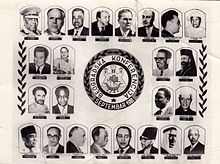Lebanon–Yugoslavia relations
Both countries self-identified with the wider Mediterranean region and shared membership in the Non-Aligned Movement.[1] Lebanon participated at the 1961 First Conference of Heads of State or Government of the Non-Aligned Movement in Belgrade.[1] Both countries experienced significant instabilities and conflicts[2] with weak central authorities which in Yugoslav case led to complete dismemberment of federal institutions and violent breakup of the state.Both regions are religiously and culturally diverse with points of convergence representing Islam in Lebanon and Yugoslavia (Bosnia, Kosovo, Serbia, North Macedonia), Eastern Orthodoxy in Lebanon and Yugoslavia (Serbia, Montenegro, North Macedonia) Eastern Catholic Maronite Church and Greek Catholic Church of Croatia and Serbia.[1] Both Lebanon and Yugoslavia underwent substantial economic and social modernization in the period after the end of World War II which affected different regions to a different extent.
LebanonYugoslaviasplit-upSocialist Federal Republic of YugoslaviaMediterraneanNon-Aligned MovementSpecial Tribunal for LebanonInternational Criminal Tribunal for the former YugoslaviaHellenistic periodRoman EmpireByzantine EmpireOttoman EmpireIllyrian ProvincesGreater LebanonIslam in LebanonBosniaKosovoSerbiaNorth MacedoniaEastern Orthodoxy in LebanonMontenegroMaronite ChurchGreek Catholic Church of Croatia and SerbiaSaeb SalamYugoslavia and the Non-Aligned MovementYugoslav WarsLebanese Civil War1959 Mediterranean Games1979 Mediterranean GamesDeath and state funeral of Josip Broz TitoLebanon at the 1984 Winter OlympicsMinistry of Foreign Affairs (Serbia)Los Angeles TimesThird World QuarterlyForeign relations of LebanonArgentinaBrazilCanadaMexicoUnited StatesUruguayArmeniaAzerbaijanBangladeshIndonesiaIsraelJordanMalaysiaPakistanPalestineSaudi ArabiaTurkeyUnited Arab EmiratesCyprusFranceGermanyGreeceHoly SeeRomaniaRussiaEuropean UnionUnited Nations resolutions relating to LebanonDiplomatic missions of Lebanonin LebanonLebanese diasporaVisa requirementsVisa policyForeign relations of YugoslaviaAlgeriaAngolaBurundiCape VerdeRepublic of the CongoEgypt/United Arab RepublicEthiopiaMoroccoNigeriaSahrawi RepublicSeychellesSierra LeoneTanzaniaUgandaZambiaZimbabweBoliviaGuyanaJamaicaNicaraguaTrinidad and TobagoVenezuelaAfghanistanAustraliaCambodiaMongoliaNorth KoreaSri LankaVietnamAlbaniaAustriaBelgiumBulgariaCzechoslovakiaFinlandEast GermanyHungaryIrelandNorwayPolandPortugalSoviet UnionSwedenSwitzerlandUnited KingdomLittle EntenteFirst Balkan PactTripartite PactWorld War II AlliesGroup of 77Group of 15The Alps-Adriatic Working GroupOrganisation of African UnityGroup of NineCentral European InitiativeSecond Balkan PactEuropean Economic CommunityBrioni Meeting